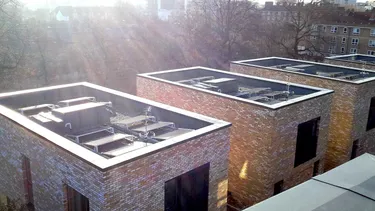
Flat roof waterproofing, the new standards that define our industry
In a nutshell, BS 6229 : 2018 describes best current practice in the design, construction, care and maintenance of roofs with a flat or curved surface, at a pitch not greater than 10 degrees to the horizontal, with a continuously supported flexible waterproof covering.
Sounds like a bit of a mouthful, but the concept is actually quite simple.
To start with, a number of definitions have been updated and new ones included:
Breather membrane – a continuous layer of highly vapour permeable material to permit the movement of water vapour in cold roof constructions (note: the level of vapour permeability required is defined in ‘BS 5250 – Code of practice for control of condensation in buildings’).
Air and vapour control layer (AVCL) – previously known as ‘vapour control layer’, this is a continuous layer of low permeability material to control the movement of air and water vapour, as in situ they perform the two functions (note: the term ‘vapour barrier’ is also redundant, having been omitted from the 2003 code of practice and should be avoided).
Water flow reducing layer (WFRL) – a robust, vapour permeable layer restricting the flow of water in an inverted roof system. It also prevents fines from being washed below the insulation, which can damage the waterproofing system or block the roof drainage system.
Blue roof – a roof designed to attenuate the rate at which rainwater is drained from the roof and is allowed to enter the drainage system.
Zero fall roofs – roofs with a slope which lies between 0 and 1:80.
As well as these new terms, further ones have been updated to provide clarity to designers and contractors alike.
Let’s look at the key points listed in the new standard.
Types of flat roof
There are four types of roof mentioned in the standard; cold roof, warm roof, inverted roof and hybrid roof. BS 6229 : 2018 focusses on cold roofs.
The full title of the new standard, published at the end of 2018, is ‘BS 6229 : 2018 – Flat roofs with continuously supported flexible waterproof coverings – Code of practice’. The title itself indicates one of the most significant changes; types of discontinuous metal roof coverings (i.e. zinc, aluminium, lead) are no longer included as the design of such roofs falls outside the scope of continuously supported flexible waterproof coverings. So it’s goodbye to those, but fear not, standard-making responsibility has been transferred to committee ‘B/542 Roofing and cladding products for discontinuous laying’ as these roofs have more in common with such constructions, and you can find them safely settled in there.
The standard advises that ‘cold roofs’ are now not recommended. You will traditionally find a cold roof over small extensions to dwellings, but because the waterproof layer constitutes a vapour control layer on the cold side of the ventilation, there is a high risk of harmful interstitial and surface condensation on the underside of the supporting structure, or the upper surface of the insulation. As it is difficult to form and maintain an effective AVCL layer below the insulation and provide sufficient cross ventilation above the insulation, it is now no longer recommended.
The good news, though, is that where this type of construction cannot be avoided, such as where there is insufficient height above the structural deck to accommodate a warm roof construction, there are certain construction principles that can be followed, like the use of 25mm battens to support the ceiling boards, a cross-ventilated void (minimum 50mm) or a fully waterproof breather membrane.
Zero Fall Roofs
Let’s go back to zero fall roofs. You may have heard them referred to as zero pitch, zero degree or dead flat roofs, but whatever the name, their definition is important.
That’s because, for the first time, the standard defines a ‘zero fall roof’ as a “roof with a slope which lies between 0 and 1:80”. This means that, in order to ensure a finished surface with a zero fall, a design fall of 1:80 should be used and a detailed structural analysis should account for construction tolerances, settlement and deflection under load. If there are negative falls, then remedial action should be taken to avoid ponding water, e.g. localized screed or the addition of rainwater outlets at the lowest point.
In short, back falls and ponding are not acceptable. In order to ensure a finished surface with a zero fall, a design fall of 1:80 should be used. Remember, a flat roof is not flat and a zero fall roof is definitely not flat!

Rainwater Disposal
The standard for rainwater disposal continues to recommend that the waterproofing is taken up to a height of at least 150mm at all upstands and abutments. However, following advice from the National House Building Council, this height can be relaxed to 75mm at door thresholds onto balconies in order to assist designers to meet the requirements of level access.
Thermal Performance
COLD BRIDGING
BS 6229 : 2018 also references ‘cold bridging’. This is an area in a building where a gap occurs in the insulation (e.g. the roof/wall junction). As these areas are colder than the main areas there is a greater risk of condensation forming, which then comes with the added problem of mould.
In accordance with the Building Regulations guidance [N2] designers should ensure there are no reasonably avoidable thermal bridges in the insulation layers caused by gaps within the various elements and at the joints between elements and components.
It is worth noting that in the new standard, reference is made to SAP 2012, whereas this has been revised and published as SAP 10. However, SAP 10 cannot currently be used in any official publication until it is incorporated into the Building Regulations, which may not be until sometime in 2020. Until then, it is hoped that amendments to BS 6229 can be made to include the new value.
INVERTED ROOFS
In 2003, the concept of including a water flow reducing layer (WFRL) above the insulation was only in its infancy. Tests were carried out by manufacturers of suitable insulation using a method in ‘Appendix C ETAG 031-1 Guidelines for European Technical Approval of Inverted Roof Insulation Kits’. They were able to demonstrate that the inclusion of a WRFL eliminated or reduced the flow of water, meaning they could then reduce the thickness adjustment.
However, apply that to a real roof and you hit all sorts of problems due to imperfections resulting from poor detailing or workmanship, causing water to flow through to the waterproofing. Not ideal.
Therefore, until further research and test evidence is made available, the standard advises to increase the design thickness of the thermal insulation, as calculated with correction factors provided by the European Technical Approval Guidelines (ETAG) test by no less than 10%.
INTERSTITIAL CONDENSATION
Control of condensation is fully covered in the BS 5250 code of practice for control of condensation in buildings, which is also under revision, so the committee felt that there was no need to duplicate the advice in BS 6229.
The requirement remains the same though; in assessing the risk of interstitial condensation, designers should use an external temperature of -5°c for 60 days during the heating season, to allow for the cooling effect of clear sky.
SURFACE CONDENSATION
To ensure there is no risk of internal surface condensation, BS 6229:2018 keeps it nice and simple and replicates legislation guidance, which requires the roof of a heated building to be insulted to provide a U-value that does not exceed 0.35 w/m2k at any point.
Blue Roofs
As defined within BS 6229 : 2018, a blue roof is a “roof designed to attenuate the rate at which rainwater is drained from the roof and is allowed to enter the drainage system.”
The standard covers inverted blue roof design, however this isn’t something that we at Axter actually recommend. The reason for this is due to the detrimental effect upon the thermal performance of the insulation; the European Technical Approval Guidelines (ETAG) test does not allow for a head of water, therefore the thickness of thermal insulation on an inverted blue roof will significantly increase and become impractical.
Unfortunately, this also means that there is already a substantial number of blue roof projects that have been completed that will fail from a thermal design point of view.
Our advice is that blue roofs should be of a warm roof construction as inverted designs, when calculated correctly, will likely be impossible to construct due to level access requirements and compromised threshold heights.
To summarise, the code of practice will:
- Eliminate inaccurate and unproven thermal performance of inverted roofs, especially when constructed as part of a blue roof type.
- Seek to improve cold roof design, yet it does acknowledge impracticality in favour of an inverted or warm roof design.
- Seek to eliminate misunderstanding over zero fall design, which will improve construction falls and roof drainage design.
- Eliminate zero falls in gutters and poor thermal performance within gutters and sumps.
We all know the flat roof sector is developing fast with new materials and design methods, and the new and updated standard has worked hard to include all relevant development and change.
For a more in-depth look into the sections above, click here to see slides on BS 6229:2018 and its definitions. We also offer a RIBA approved CPD where you can learn more about the changes to the new standard. Click below to read more about the CPD or contact us to book your place and/or to request more information.
05th March 2019
